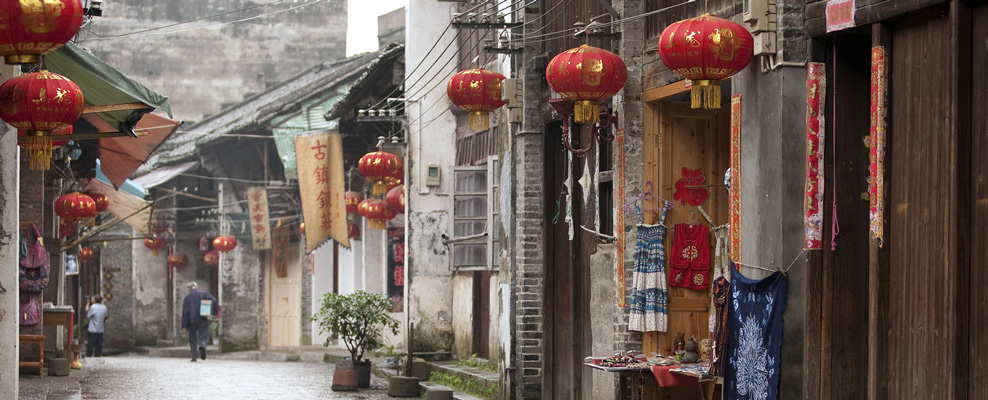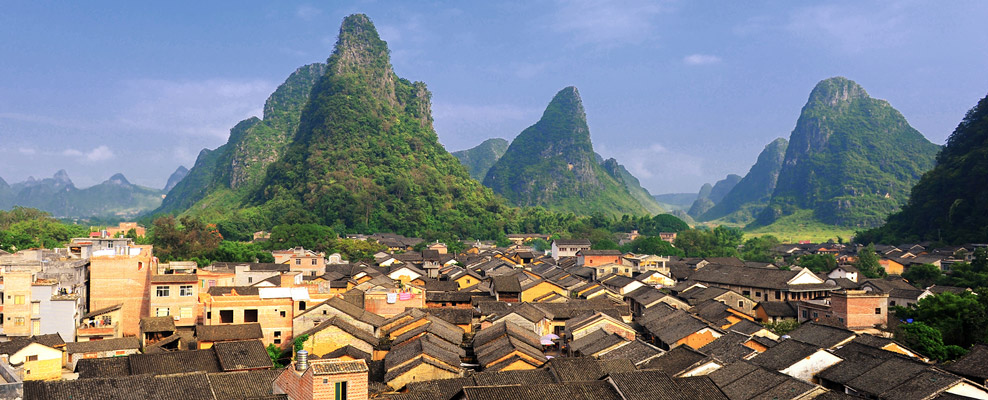Guilin's Ancient Towns & Villages
We've put together a photographer's overview of the ancient towns and villages in the Guilin area, covering as far north as Chengyang, and south to Huangyao. We hope this helps you get a feel of what's on offer in the Guilin and Yangshuo area.
When to Photograph Ancient Towns
Our photography itineraries typically visit the ancient towns in the midday or afternoon light, as most photographers coming to Guilin are focused on landscapes, rather than ancient villages. We preserve the golden hours and early and late afternoons for landscape work and visit the ancient towns at other times of the day.
Visiting ancient towns in Guilin during a harsher midday light still works well, as these areas offer a different style of photography, a close-up style, capturing that feeling of bygone era that you imaged China to be. So we typically work in some ancient town photography during lunch, or time it for afternoon. It can be also nice even at noon and bright times, as light falls nicely down stairs or through a narrow alley.
Every trip is customized to each photographers interests and style, and we can visit this at times you prefer, and even overnight for those sunrise or evening lantern shots.
Our photography itineraries typically visit the ancient towns in the midday or afternoon light, as most photographers coming to Guilin are focused on landscapes, rather than ancient villages. We preserve the golden hours and early and late afternoons for landscape work and visit the ancient towns at other times of the day.
Visiting ancient towns in Guilin during a harsher midday light still works well, as these areas offer a different style of photography, a close-up style, capturing that feeling of bygone era that you imaged China to be. So we typically work in some ancient town photography during lunch, or time it for afternoon. It can be also nice even at noon and bright times, as light falls nicely down stairs or through a narrow alley.
Every trip is customized to each photographers interests and style, and we can visit this at times you prefer, and even overnight for those sunrise or evening lantern shots.
Xingping Area Towns & Villages
Xingping Ancient Town
Xingping is the place next to the view on the 20 yuan note, which is why it's pier area is full of Chinese tourists. The motorized bamboo raft cruise from Yangdi also finishes here. The main ancient street is now full of shops and cafes, but nothing like West Street in Yangshuo, and still very pleasant for photographers to explore. There are also some back alleys with lovely views of the smaller river. You can also see the Tengjiao Temple exterior. Although often closed it has great architectural details and a decorative roof and windows which is the subject for many art students.
The best view over the river bend and the undulating karst mountains is from the top of Laozhai Mountain. The trek up is strenuous to most, involves one metal secure ladder, but it's very wide and safe.
In the middle of summer it is best to do the climb in a cooler part of the day, as it has nearly 1200 steps. However, it does make a good activity for a midday activity, as the path is fully shaded by the trees and bamboo.
The Bird's View Pavilion on the top offers a nice place to rest. For convenience and cost (no fees, cars or rafts required) it is one of the best options for mountain landscape photography, if you are reasonably fit and not afraid of heights.
The best view over the river bend and the undulating karst mountains is from the top of Laozhai Mountain. The trek up is strenuous to most, involves one metal secure ladder, but it's very wide and safe.
In the middle of summer it is best to do the climb in a cooler part of the day, as it has nearly 1200 steps. However, it does make a good activity for a midday activity, as the path is fully shaded by the trees and bamboo.
The Bird's View Pavilion on the top offers a nice place to rest. For convenience and cost (no fees, cars or rafts required) it is one of the best options for mountain landscape photography, if you are reasonably fit and not afraid of heights.
Yucun Village (Xingping)
Yucun (means fishing village) is a short boat trip upstream from Xingping, or it can be trekked to either form Yangdi direction, or from Xingping. This village is off the tourist track and offers a mid-day photography activity while staying in the Xingping area.
Yangshuo's Ancient Towns & Villages
Jiuxian Ancient Village (Yangshuo)
Jiuxian (means old county) village is near the Yulong River, about 8km from Yangshuo. First established in Sui dynasty (A.D.590 – A.D.618) 1400 years ago, it retains much of the old mud brick farm houses and Qing Dynasty grey brick mansions built for government officials and rich landlords, unlike most other villages nearby. It is surrounded by karst peaks and paddy fields. Some houses are being restored; some have fallen to disrepair, but all in all it is a charming stop on a long bike ride.
This small ancient village is nearby the punted bamboo rafts, and the Tea Cozy hotel and makes a good lunch or afternoon coffee stop off.
Admission: Free
This small ancient village is nearby the punted bamboo rafts, and the Tea Cozy hotel and makes a good lunch or afternoon coffee stop off.
Admission: Free
Huangyao Ancient Town
Huangyao gets its name form the two ancient families that lived there, The Huang's and Yao's. It has over 1,000 years history, has beautiful pavilions and temples, unique folk houses and eight ancient stone roads and a few 800 year old banyan trees.
Huangyao was first built during the Song Dynasty but flourished during Ming and Qing Dynasties. It owes its preserved state to being surrounded by mountains at the end of countryside roads. The town's relics and traditions have been left intact, untouched by outside conflicts.
The American film “The Painted Veil” was partially filmed in Huang Yao, and so has brought more visitors to this sleepy little town, but more often than not you are still the only foreigner in the place. It is possible to get there in the evening, stay the night in a local hotel, as there is some great night photography options on the streets, and then see the sunrise and have early morning here before heading back just before lunch when light is not so good.
Hours: Open all day long (ticket: 7:30 a.m. - 5:30 p.m.)
Admission: 100 yuan
Huangyao was first built during the Song Dynasty but flourished during Ming and Qing Dynasties. It owes its preserved state to being surrounded by mountains at the end of countryside roads. The town's relics and traditions have been left intact, untouched by outside conflicts.
The American film “The Painted Veil” was partially filmed in Huang Yao, and so has brought more visitors to this sleepy little town, but more often than not you are still the only foreigner in the place. It is possible to get there in the evening, stay the night in a local hotel, as there is some great night photography options on the streets, and then see the sunrise and have early morning here before heading back just before lunch when light is not so good.
Hours: Open all day long (ticket: 7:30 a.m. - 5:30 p.m.)
Admission: 100 yuan
Fuli Town (Yangshuo)
Fuli is a small town 8km from Yangshuo, famous for the hand painted paper fans. Li River bamboo rafts stop here, which makes it popular. Apart from a small section of the old town on the river bank it is a fast developing typical Chinese rural town with concrete buildings. If you wish to buy some gifts to take home, this may be of interest, not so much for photography merits. We tend to include Fuli as part of a bike ride, or electric bike paparazzi experience when photographing Yangshuo by day.
Guilin's Ancient Towns
Daxu Ancient Town (Guilin)
Daxu Village was a thriving hub of commerce until 1930's, owing its success to its position at the meeting point of four rivers. The deep blue stone slab streets, courtyard buildings and the charming Qing Dynasty bridge still tell of the former glory days.
The main attraction lays in the side streets, where life still goes on in age old fashion. We have a relationship with an elderly gentleman who lives in a Ming Dynasty house. This enthusiastic collector has become our good friend, and he has an amazing array of gizmos and gadgets which he loves to show friends we bring.
Daxu museum is currently still being constructed (date writen Feb 2014), our local friend has undertaken the project.
Top Photography Tip: Daxu is amazing on a rainy day, and at Chinese New Year when at special times you can capture the local villagers Lion Dance, and the rich culture that surrounds it.
Admission: Free
The main attraction lays in the side streets, where life still goes on in age old fashion. We have a relationship with an elderly gentleman who lives in a Ming Dynasty house. This enthusiastic collector has become our good friend, and he has an amazing array of gizmos and gadgets which he loves to show friends we bring.
Daxu museum is currently still being constructed (date writen Feb 2014), our local friend has undertaken the project.
Top Photography Tip: Daxu is amazing on a rainy day, and at Chinese New Year when at special times you can capture the local villagers Lion Dance, and the rich culture that surrounds it.
Admission: Free
Jiuwu (Jiangtou)
Jiangtou is a farming village 35 km north of Guilin, that is becoming more popular with tourists. It is not really en route anywhere, so it is a little out of the way. It has a 800-year history and is locally known for having produced an unusually large number of academics through the centeries. People here still value education highly.
The Lonely Planet reports 15-20K but is actually wrong, it is 35-40k. each way. In this area you will pass locals drying fruit, basking in the sun or tend to their fields much as they have done for centuries.
The Lonely Planet reports 15-20K but is actually wrong, it is 35-40k. each way. In this area you will pass locals drying fruit, basking in the sun or tend to their fields much as they have done for centuries.
Villages to the North of Guilin
Longji Rice Terrace Villages (Longsheng)
Ping'an Village, Longji Terrace, Longsheng Terrace Fields, a beloved child has many names. Ping'an is one of the villages in the area, considered having the most beautifully shaped terraces, but is consequently also most touristy.
The construction of the terraces started in Yuan Dynasty and went on for over 650 years. The poetic name was given due to the terraces giving the mountain the look of dragon's scales, and the ridge resembling the backbones.
The area is very large and lends itself to hiking, the altitude varies from 300 to 1,100 meters. Late May to early June is the absolute best time to see the irrigate fields with their reflecting surfaces, whereas later in the summer the green shoots make a vivid sight. Colors slowly change to yellow, ripening for harvesting and in early October. Until the next May the fields are brown and fairly dry.
Travel Tips:
Hours: all day long
Admission: 80 yuan
DIY Travel Advice: Take the bus from Guilin Bus Station to Longsheng. On route change to a local minibus at a road junction before you arrive in Longsheng, the bus courier can help you. Then take a local minibus for less than 2 dollars towards Heping town, finally another change towards Shuanghekou.
The construction of the terraces started in Yuan Dynasty and went on for over 650 years. The poetic name was given due to the terraces giving the mountain the look of dragon's scales, and the ridge resembling the backbones.
The area is very large and lends itself to hiking, the altitude varies from 300 to 1,100 meters. Late May to early June is the absolute best time to see the irrigate fields with their reflecting surfaces, whereas later in the summer the green shoots make a vivid sight. Colors slowly change to yellow, ripening for harvesting and in early October. Until the next May the fields are brown and fairly dry.
Travel Tips:
Hours: all day long
Admission: 80 yuan
DIY Travel Advice: Take the bus from Guilin Bus Station to Longsheng. On route change to a local minibus at a road junction before you arrive in Longsheng, the bus courier can help you. Then take a local minibus for less than 2 dollars towards Heping town, finally another change towards Shuanghekou.
Chengyang's 8 Dong Villages (Sanjiang)
Chengyang has eight Dong ethnic villages, totaling over 10,000 people. These villages still are rich in traditional Dong heritage and style. The Dong people still make and wear their iconic indigo clothes, and you can often see fabrics being made today.
The most famous sights are the traditional wood buildings, such as the drum towers, The Wind and Rain Bridge and the multilevel homes, made from tongue and groove construction techniques which involve no nails.
The Wind and Rain Bridge, built in 1912, is the largest in the world of its kind and is protected as a cultural relic.
Hours: all day
Admission: 60 yuan
How to get there: Once in Sanjiang (3.5 hours from Guilin) take a local bus from Hexi Bus Station at Sanjiang County.
The most famous sights are the traditional wood buildings, such as the drum towers, The Wind and Rain Bridge and the multilevel homes, made from tongue and groove construction techniques which involve no nails.
The Wind and Rain Bridge, built in 1912, is the largest in the world of its kind and is protected as a cultural relic.
Hours: all day
Admission: 60 yuan
How to get there: Once in Sanjiang (3.5 hours from Guilin) take a local bus from Hexi Bus Station at Sanjiang County.
Get a quick understanding of Guilin Guilin Photography Map
Locations by style Photography Locations Info-graphic
Locations by style Photography Locations Info-graphic
Questions or Comments - No Signup Required!
No need to sign up!
Copyright 2014 All Rights Reserved. Protected by Copyscape and CopyGator.




